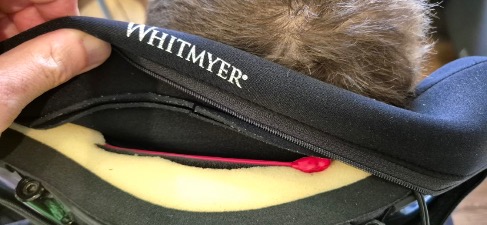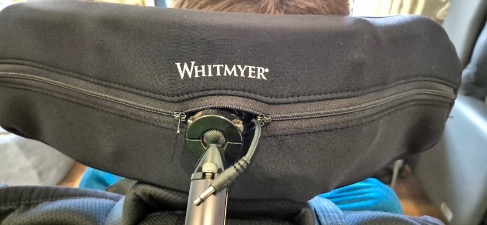
Case Study
A Need For Speed – Assistive Technology For YouTube Game Play
How my client Harry is able to use assistive technology to play the racing game, Need For Speed, and film his game play for YouTube.
Watch Harry play on his YouTube channel.
Assistive Technology Uses
In visits to Harry, we cover a range of uses for his assistive technology, including:
- College support,
- Home IT and computer activities,
- Gaming
- Communication,
- Independent writing.
Harry is a keen gamer and in past sessions we have explored a bespoke assistive technology set up which he has been able to use to control and play Mario Kart.
Assistive Technology For Gaming
Harry often expresses an interest in broadening the range of games he can play with assistive technology.
He told me that he was finding Mario Kart too slow. He wanted a game which would allow him to race quicker – at speeds of 200mph and beyond.
Since Mario Kart encourages drivers not to break the speed limit of 70mph – this made a lot of sense!
Console Gaming Control
I recommended Need For Speed, which is a more realistic racing game than Mario Kart. We spent a session configuring his on-screen eye control overlay so that he could best control his car.
The configuration of the on-screen eye control interface is a slow process. It requires the user to try out the effectiveness of the control cells I create. So, for the majority of the session Harry started and paused gameplay while I made the necessary adjustments in response to control effectiveness.
Now that Harry could independently control the steering of the car, to accelerate he’d need to be able to press and hold a switch, while simultaneously using his eyes to steer. This combination of actions proved unachievable with switches positioned by his hand or knee, locations that have been accessible for him during other control operations.
The average gamer may not give it much thought, but every game has different controls for different actions. When setting up assistive technology for gaming, this must be taken into account as well as what actions the disabled gamer in question is consistently and comfortably able to take.
For now, another person was required to hold down the accelerate button while Harry raced his car. Enjoyable, but not ideal.
Harry expressed the desire to play Need For Speed completely independently, so before our next session, I looked for the solution.
Solution – Head Mounted Switch
So we’d tried hand and knee operated switches with no success. This time I brought a pillow switch to use to control acceleration in the game.
The hypothesis: that Harry’s natural, head-back position would press the switch and accelerate the car, and he’d bring his head forward to slow down.
Unfortunately, this was ineffective in combination with using eye-gaze to steer. His head would roll off the pillow switch whenever he changed the direction of his gaze. Seeing this in practice made me realise that I also move my head along with my eyes, as I’m sure many people do!
But trial and error is often required for bespoke assistive technology to work, and I had an alternative switch in my inventory made of a pressure sensitive strip. I positioned this inside the headrest of Harry’s chair, holding it in place with a simple piece of Velcro. With the zip cover fastened it remained comfortably in place.


With this new switch connected to the accelerate input on the games console, Harry was able to use his head to control his speed, enabling him to finally complete a race independently.
Youtube Game Play
Being about to embark on a college course studying media, Harry has long desired to create video content to post on social media.
I introduced him to a free screen recording software and he is now able to record his gameplay featuring his own image in the corner of the screen. Ideal for YouTube game play videos.
We explored together how he could use a green screen and edit out the background of his bedroom behind him, replacing it with a graphical image. Harry has since bought his own green screen and records his gameplay to upload to YouTube.
Now in my sessions with Harry, I help him edit the game play videos he records with built-in Windows video editing software, and he uploads them to his YouTube account.
Transferable Skills
As well as being able to achieve his gameplay goals, the use of assistive technology provides Harry with excellent transferable skills which will be invaluable as he embarks on his college course. In making and editing YouTube videos, he’s exercising control of the cursor in the video editing software, employing file management in saving, locating, renaming and loading required files, and in coming up with and typing video titles and descriptions.
The process of gaming with on-screen eye control interfaces, plus investigating and trying out button switch positions for use in conjunction with eye gaze has equipped Harry with so many skills he can use in other aspects of his life.
Although reaching speeds of above 200mph was his motivation, he is now equipped to use two types of assistive technology together to control two actions at once, something that will serve him well for other leisure activities, learning, communication and overall independence and quality of life.
Further Assistive Technology Support From Sensation CTS
We provide bespoke assistive technology set ups to help our disabled clients become more independent, and we can also give follow up training and instruction to relatives, personal assistants, care staff etc.
We pass on the skills to facilitate the continued use of the technology, supporting the client to remain as independent as possible in their day to day lives.
How Sensation CTS supported Harry with assistive technology for gaming.